In the East, the pomegranate is known as the "king of fruits" for its exquisite taste and beautiful appearance. A single fruit contains a wealth of nutrients essential for the human body. In folk medicine, pomegranate seeds and peel are used to treat anaemia, dysentery, gastrointestinal disorders, and other ailments.
Pomegranate trees are cultivated on an industrial scale in many countries and cities with a subtropical climate. These trees are particular about climate but undemanding in care. Where pomegranates are grown, how they grow in the wild, and when they ripen – read on to find out.
Table of contents
Description and Characteristics of the Pomegranate
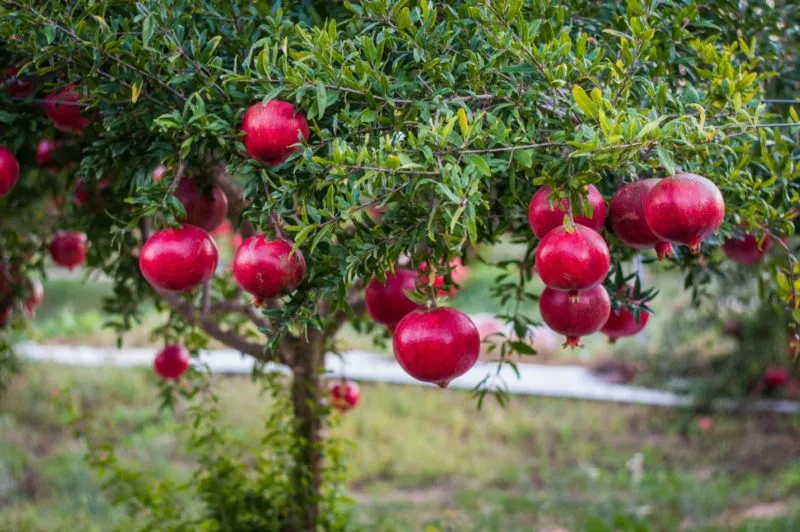
The pomegranate is a long-lived plant from the Lythraceae family, genus Punica. On average, it actively grows and bears fruit for about 100 years. In the wild, some trees have been found to be around 300 years old.
When grown commercially, pomegranate plantations are typically replaced every 50–60 years, as yields decline with age.
Did you know? In medieval times, the pomegranate was called Pomum granatus, meaning "seeded apple." In Ancient Rome, it was known as Malum granatus – "grainy apple." Later, Carl Linnaeus gave it the official name Punica granatus, meaning "Punic grainy." In Italian and German, the name still translates to "apple."
Pomegranate trees thrive in subtropical climates. They can withstand temperatures as low as –15°C, but at –20°C or below, their above-ground parts freeze.
The plant is light-loving, so it is planted in open areas. To ensure large, sweet fruits, they must be shaded by leaves – a key consideration when pruning.
Pomegranates are not fussy about soil type and can even grow in sandy or saline soils.
They are hardy and known for their resilience. If a tree’s trunk and branches are buried in sand, it can grow new adventitious roots while the old root system withers. This phenomenon is evident in ancient pomegranate "cemeteries" found near the Ganja-Gay River, where multiple layers of roots have formed along buried trunks.
Pomegranates are drought-tolerant and do not require frequent watering. However, occasional misting and irrigation during dry spells can improve fruit quality.
Like all cultivated plants, pomegranates are susceptible to diseases and pests. Common issues include branch canker (Phomopsis) and sooty mould. Pests such as pomegranate mites, carnation leaf rollers, wood borers, pomegranate fruit moths, and aphids can also be problematic.
Breeders continually develop new, more resistant varieties. In commercial farming, chemical treatments are used to manage these issues.
Botanical Description
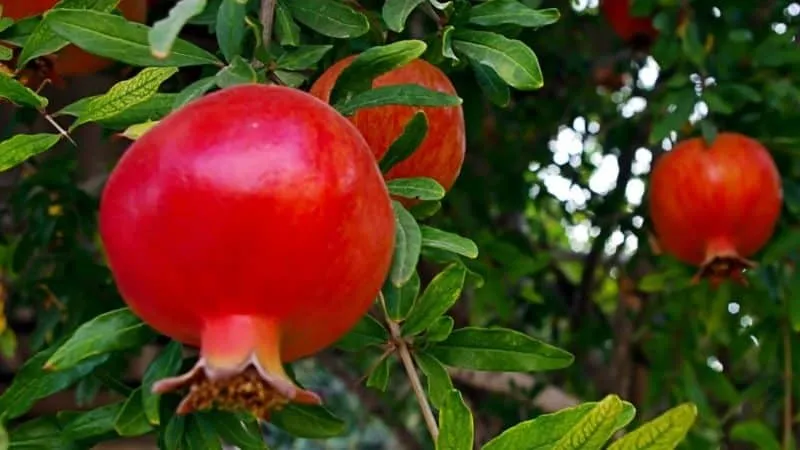
Pomegranates are not just a source of delicious and nutritious fruit – they are also ornamental, especially when flowering or fruiting.
Cultivated varieties are usually grown as trees, reaching 3–6 metres in height. In the wild, their form varies: in mountainous or poor-soil areas, they grow as shrubs.
The branches are thin but flexible and strong enough to support heavy fruit. They often have thorns, which are longer and sharper in wild varieties.
The leaves are opposite, elongated, pointed at both ends, glossy, and bright green. They grow up to 8 cm long and 2 cm wide. In tropical climates, pomegranates are evergreen, but in colder regions, they shed leaves in winter.
There are two types of flowers. Bell-shaped ones are sterile and fall after blooming. These make up the majority. Jug-shaped flowers are bisexual, with a visible ovary at the base, and develop into fruit.
Intermediate flower forms also exist. Fruit-bearing pomegranates have simple red-orange flowers with a leathery calyx of 5–7 pointed lobes. Inside are delicate petals, stamens, and a lobed pistil. Ornamental varieties may have double flowers in red, pink, white, or variegated hues.
The fruit is spherical, with a persistent leathery calyx resembling a crown. Botanically, they are called "balustrades." The tough, inedible rind – typically red (most common), yellow, orange, brown, or burgundy – protects the pulp and is used in medicine and cosmetics.
Inside are hundreds of seeds (up to 1,200) encased in juicy arils, which can be dark red, light red, pink, or yellow. The taste ranges from tart to sweet. Seeds are arranged in 6–13 chambers separated by a creamy membrane. They may be hard or soft, enabling seed propagation.
Did you know? A single pomegranate tree can yield around 60 kg of fruit per season.
Origin and Historical Roots
Scientists believe pomegranates are an ancient crop, dating back at least 4,000 years. Some suggest Stone Age humans consumed them.
The pomegranate’s historical homeland is Persia (modern-day Iran). In ancient times, it also grew wild in Carthage (Tunisia), Afghanistan, Turkey, the Caucasus, and Central Asia.
Domesticated early, pomegranates spread across the Mediterranean. Spanish conquistadors later introduced them to the Americas. Today, they are cultivated in all subtropical regions.
Greece held pomegranates in particularly high esteem. Poets celebrated them, and golden pomegranates were awarded to elite warriors. The fruit also appears in the Old Testament.
Fun fact: Some cultures believe the pomegranate was the "apple" that tempted Eve in the Garden of Eden.
How Wild Pomegranates Grow
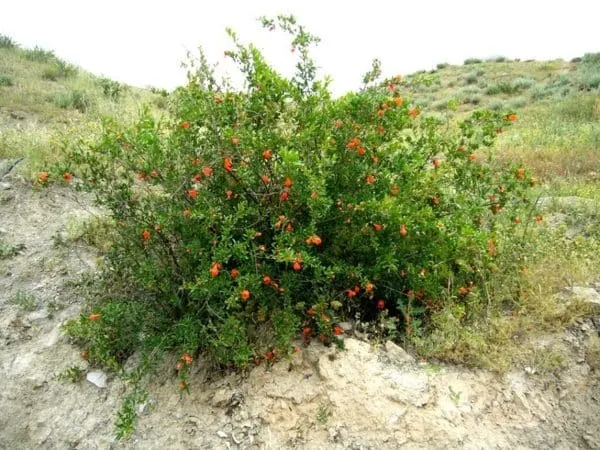
Wild pomegranates thrive along ridges, near mountain rivers, and in rocky, sandy, or gravelly soils.
In favourable conditions, they grow into tall trees. On slopes, they become shrubs. The harsher the environment, the smaller the plant.
Wild pomegranates are smaller than cultivated ones, with a tart, tangy flavour. Their rind is bright red or orange with light spots, and the arils are pale red with hard seeds.
Geographic Regions Where Pomegranates Are Grown
Pomegranates flourish in countries with mild subtropical climates, both wild and cultivated.
Their natural range includes Western Asia: Turkey, Armenia, Iran, Georgia, Afghanistan, and Azerbaijan. The northern limit extends to the Greater Caucasus and the Caspian Sea coast, while the southern reaches the Arabian Sea.
Commercial plantations are found in the Middle East, Greece, Afghanistan, Iran, Italy, Spain, France, Portugal, and the former Yugoslavia.
In Europe, pomegranates grow in southern Spain, Sicily (Italy), and Crete (Greece).
Where the Best-Tasting Pomegranates Grow
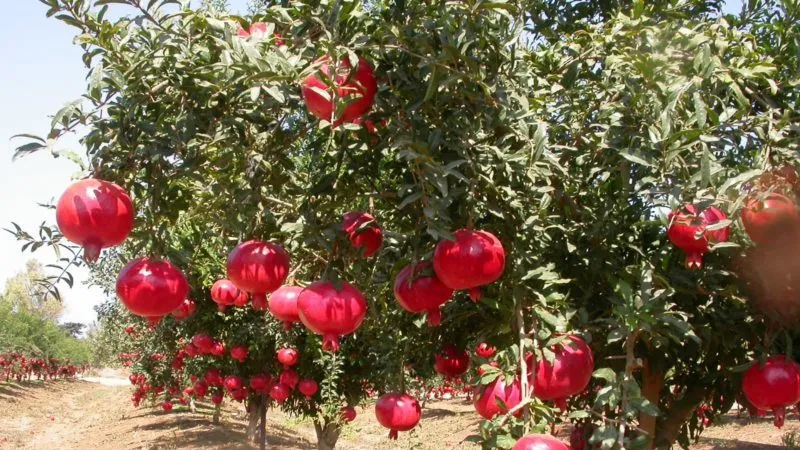
There’s no consensus on where the tastiest pomegranates grow – opinions vary by country.
Azerbaijani pomegranates are renowned for their rich flavour. The city of Goychay hosts an annual pomegranate festival, and its fruits are a national favourite.
Many argue that the best pomegranates come from Iran, their ancestral home. Greeks, however, swear by Tunisian varieties, historically prized in their culture.
Note: Flavour depends more on variety and growing conditions than origin. Sweet, tart, and balanced types exist. Ideal conditions – fertile soil and temperatures around +25°C – yield the best fruit.
Pomegranate Varieties by Region
There are three main pomegranate species:
- Common pomegranate (Punica granatum). The source of all cultivated varieties, prized for its taste. Grows wild in Western Asia and Southern Europe.
- Socotran pomegranate (Punica protopunica). Native to Yemen’s Socotra Island. Less palatable, so rarely cultivated.
- Dwarf pomegranate (Punica nana). Recently classified as a separate species. Produces small fruits and is grown as an ornamental houseplant.
Key varieties and their growing regions:
- Sweet varieties: Asward, Sharozi, Ahmadi (Iran); Bedana, Dholka (India); Nar Shirin (Middle East). Almost no acidity.
- Soft-seeded: Wonderful (USA, Spain). Seeds are edible.
- Sweet-tart: Mollar de Elche (Spain), Gabsi (Tunisia). Balanced flavour.
- Tart: Hicaz (Turkey), Parfianka (Central Asia). Bold, tangy taste.
- Early-ripening: Akko (Israel), Early Foothill (Spain). Ready by September.
Popular ornamental varieties include Flore Pleno (double flowers) and Legrellei (variegated petals).
When Pomegranates Ripen
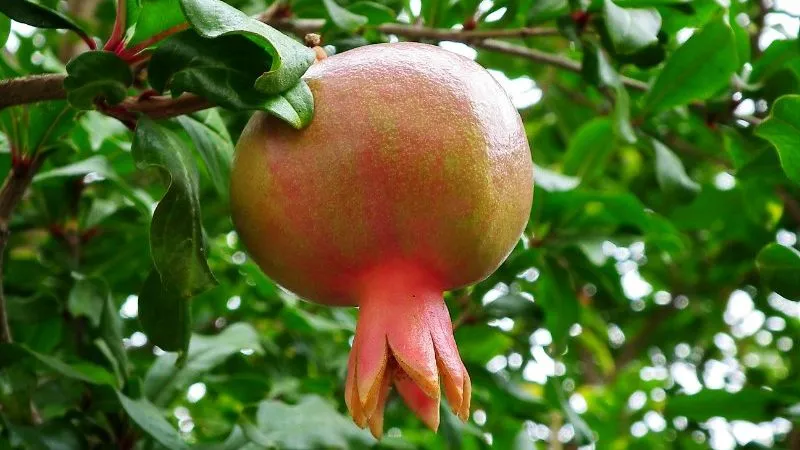
Pomegranates bear their first harvest at 3–4 years old. Grafted trees may fruit in year two. Productivity peaks at 55–60 years, though trees live over a century.
The growing season lasts 6–8 months. Flowering, fruiting, and ripening are staggered. From blossom to harvest takes 4–5 months.
In hot climates, ripe pomegranates split open on the tree without losing seeds. These are too delicate for export but beloved locally for their intense flavour.
In cooler areas, leaves often fall before harvest, leaving bare branches adorned with bright fruit.
Ripening seasons by region:
- Spain: October–December, depending on variety.
- Italy (Sicily): Late September–November.
- Greece: October is peak season.
- Turkey: Major exporter; harvest runs mid-September through October.
- Tunisia: Early varieties ripen in September.
- Israel: August–February; a key supplier to Europe.
How to Identify Ripe Pomegranates
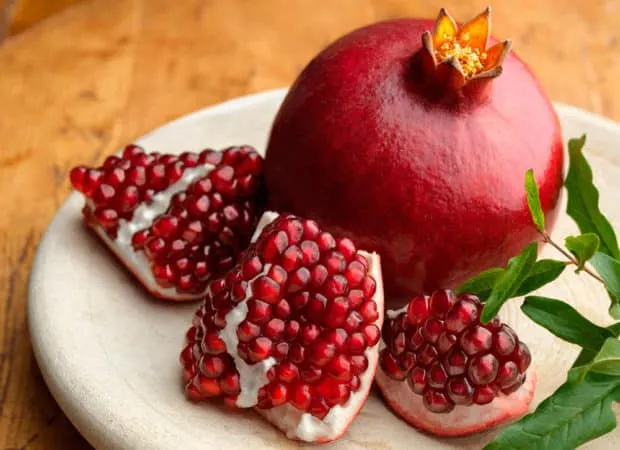
Picked unripe, pomegranates will soften but not sweeten further. For best flavour, harvest when fully ripe. They store well for over 3 months.
Signs of ripeness:
- Seeds: Ripe arils are elongated with visible ridges.
- Colour: Deep red, pink, or burgundy rind. Light patches indicate immaturity.
- Texture: Skin should be dry, unblemished, and crack-free (cracks mean overripeness).
- Sound: A metallic ring when tapped; dull thuds mean it’s unripe.
- Scent: Strong aroma suggests underripeness; ripe fruit has little smell.
- Weight: Heavier fruit = juicier seeds.
- Calyx: Dry, without green traces.
Conclusion
Pomegranates have spread across subtropical regions worldwide, even to southern Europe. These hardy trees survive brief frosts (–15°C) and hold fruit late into autumn.
Ripening varies by location and variety, but the main harvest runs from late September through November.







